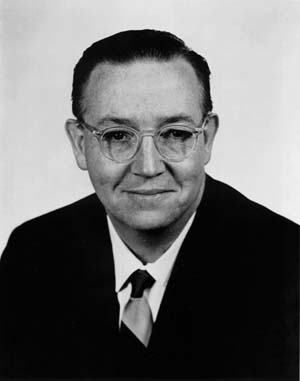Remarks by James T. Ramey, Commissioner U.S. Atomic Energy Commission
It is always an honor and a privilege to participate in ceremonies such as today's groundbreaking. But it is an even greater pleasure when you are a native who has returned to his state to help commemorate a project of great interest locally, nationally and personally.
Actually this is the second laboratory site selection and activation in which I've been involved in the Chicago area. Twenty years or so ago, when I was counsel for AEC's Chicago Office, the then Federal District Attorney, Otto Kerner, and I worked very closely in obtaining the site for AEC's Argonne National Laboratory. Thus it is that I have an "I've-been-here-before-feeling" right now - but I also have something of the same sense of excitement that I felt back then - the excitement of being-witness to man's willingness to meet a great challenge. At that time, it was the potential of atomic power which is now becoming a reality.
At this time, research in facilities such as the 200 Bev Accelerator can unlock the mysteries of the universe. My colleagues are better qualified to discuss the nature of the research than I. But while the promise of such research is great, so are the investments which must be made by those who choose to become involved in its pursuit. I would like to take this opportunity to acknowledge the fact that the State of Illinois, in an act of farsightedness - and in my view, considerable courage - has volunteered to make such an investment in the scientific future of this Nation. In competition with 45 other states seeking to provide a home for the 200 Bev Accelerator Facility, the State in 1965 offered to make 6800 acres of choice land available as a site at no cost to the Federal Government. It is never a small decision for a State - and its people - to give up such a tract of land. And it has been a particularly complex task in a metropolitan area such as this, requiring as it does, considerable expenditures of state funds, termination of an existing community in Weston and the displacement of families, some of which have farmed their lands for generations. The fact that we are here today commemorating the start of permanent construction of the accelerator facilities is a vivid testimonial to the effort that has been expended by the State to this end.
The National Accelerator Laboratory is operated by the Universities Research Association, Inc., for the U.S. Atomic Energy Commission.
So it is on behalf of my fellow Commissioners and myself that I commend the State of Illinois, its Congressional Delegation, its State and local officials and its people for the farsightedness they have shown in embarking on this adventure. This certainly includes many distinguished persons here on the platform and in the audience, and some who could not make this occasion.
But all the challenges that have been met to date involving the imagination and efforts of the State, the National Accelerator Laboratory and the Federal Government may have only been an introduction to the greater challenges that lie ahead.
The time schedule for the accelerator calls for production of a beam of protons by July of 1972. To build an immensely complicated first-of-a-kind machine that works at all is in itself a great challenge. To aspire to do so on this time schedule is a recognition by all concerned that if we are to obtain maximum gains from new scientific tools such as the accelerator - if we are to avoid possible penalties in high costs and low morale - we must strive to cut the lead time involved in the development and construction of these scientific tools to a minimum. This is what Bob Wilson and his colleagues believe - not hope - but believe they can do!
The Laboratory simultaneously seeks to meet another challenge - that of providing equal opportunity in terms of employment and housing for its employees. Thus our objective is that the accelerator is not only to be built on schedule, but it is to be built within a setting of dedication to human rights and dignity. As Chairman Seaborg has stated, the Accelerator and the Laboratory are to be an illustration that scientific progress and human progress can go forward hand in hand.
If the challenges of technical complexity, scheduling, and equal opportunity - and all the other challenges involved in this effort - are to be met, it will require the sustained cooperative effort of all of us here today. It will take a lot of doing, and I would not minimize the rough spots and problems we will encounter. Needless to state, I know we all believe it will be worth it, both in scientific, material and human terms. It is to meeting these challenges that we should dedicate our efforts again today. Thank you.




